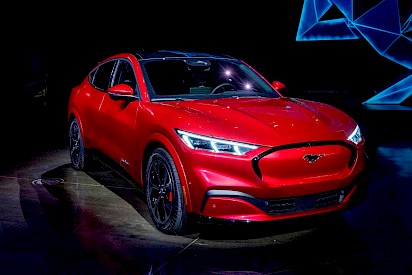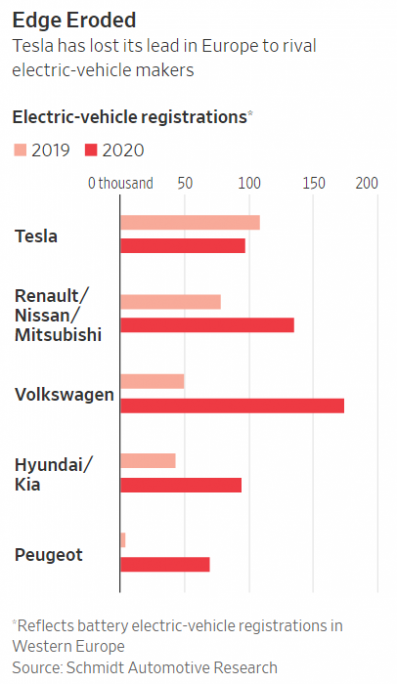Tesla faces new reality of tough competition
 Tesla Inc.’s TSLA -1.50% grip on critical markets is showing early signs of slipping as established auto makers push rival models in their race to catch up to Elon Musk’s vision for an electric-car future.
Tesla Inc.’s TSLA -1.50% grip on critical markets is showing early signs of slipping as established auto makers push rival models in their race to catch up to Elon Musk’s vision for an electric-car future.
In the U.S., Ford Motor Co. F +4.45% ’s electric sport-utility vehicle, the Mustang Mach-E, has begun eating into Tesla’s market share, according to new market data, while in Europe, the world’s largest electric-car market, Volkswagen AG beat Tesla to become the top-selling all-electric vehicle maker there last year. In other markets, such as Asia, Tesla’s market share has held up and even grown.
The Mustang Mach-E that launched to rave reviews accounted for 12% of the all-electric vehicles delivered in the U.S. last month, according to market research firm Motor Intelligence. Tesla’s share of the market fell to around 69% in February from about 79% in all of last year.
Customers in Western Europe registered roughly 98,000 Teslas in 2020, down about 11% from 2019, while overall registrations of all-electric vehicles more than doubled, according to Schmidt Automotive Research. Tesla’s share of the market fell to around 13% in 2020 from roughly 31% a year earlier.
Tesla, which doesn’t break out deliveries by region, didn’t respond to requests for comment.
Tesla for several years has been expected to face stiffer competition. Companies including Volkswagen and General Motors Co. GM +4.29% are pouring billions of dollars into beefing up their electric offerings. Tesla’s market-share losses in the U.S. and Europe could indicate those competitive dynamics are starting to play out.
 Still, auto makers are competing in a growing global market, spurred in part by government efforts to phase out gas guzzlers. Tesla also still has some strategic advantages over rivals, including a network of dedicated vehicle-charging stations.
Still, auto makers are competing in a growing global market, spurred in part by government efforts to phase out gas guzzlers. Tesla also still has some strategic advantages over rivals, including a network of dedicated vehicle-charging stations.
The emerging popularity of rival plug-in models in some markets is increasing the pressure on Tesla to increase production and expand its manufacturing footprint. “All of a sudden there are players on the other side of the playing field,” said Matthias Schmidt, an independent auto analyst based in Germany. “The key for Tesla is to increase supply.”
The growing competition comes at a bumpy time for Tesla. The company, after strong growth in 2020 despite the pandemic, briefly shut down its lone U.S. car plant in Fremont, Calif., last month due to parts shortages. Tesla also has said production this quarter could be dented by lower Model S sedan and Model X sport-utility vehicle output as it introduces updated versions of both, though it is increasing output of its Model Y compact sport-utility vehicle in China.
Tesla’s stock, which soared more than 700% last year, had retreated about 25% since its January peak as of Wednesday. Shares closed 4.7% higher on Thursday.
Although rivals have made inroads in some markets, Tesla is still growing. The company delivered nearly half a million vehicles world-wide last year, up more than one-third from 2019, and is aiming to grow at a faster pace in 2021.
Tesla in 2020 nearly tripled deliveries from a year earlier in the Asia-Pacific region, as it ramped up output at its Shanghai plant, according to EV-volumes.com, which tracks global electric-vehicle sales. That demand, the data showed, helped keep Tesla’s share of global all-electric vehicle sales relatively steady at around 22% last year.
Tesla’s long-term growth will be driven in part by two new vehicle factories it plans to open this year: one near Austin, Texas, and another outside of Berlin, its first in Europe. It also has expanded production capacity in Fremont and at its relatively new plant in Shanghai.
Some analysts see the Germany plant as key to improving the company’s fortunes in the region.
Mr. Musk has said that he expects the company’s new factories to improve delivery efficiencies. “There’s just fewer cars on boats, much less capital tied up with the cars that are on boats or being transported to customers,” he said in January.
Producing locally could allow Tesla to cut prices in Europe for its Model 3 sedan by up to 20%, thanks in large part to reduced shipping, insurance and tariff costs, analysts at New Street Research estimated in a note to investors this week.
You can return to the main Market News page, or press the Back button on your browser.

